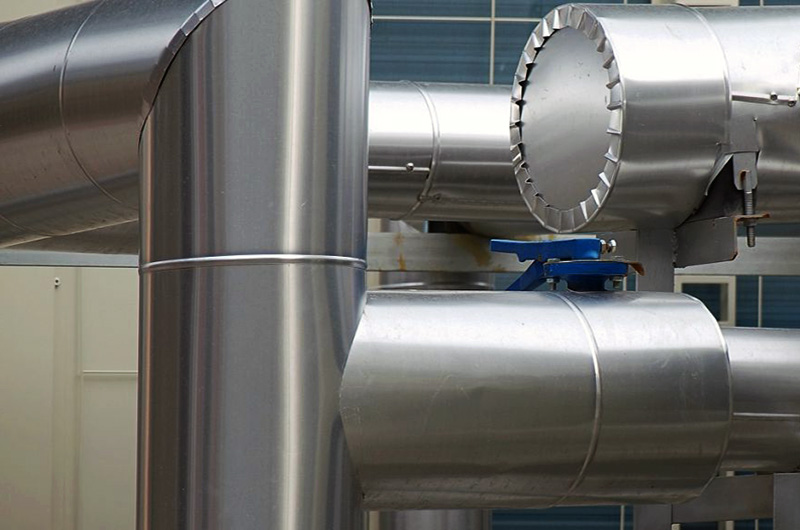Air duct ventilation systems are an important part of various industries, including HVAC (heating, ventilation, and air conditioning), automotive, aerospace, and more. These systems promote air circulation, provide comfort, maintain indoor air quality, and ensure efficient operation of machinery and equipment. At the heart of these systems lies the material used to construct the ducts, with aluminum being a popular choice due to its superior properties. Among the aluminum alloys used for air ducts, 8011 aluminum coils stand out for their superior quality and versatility.
8011 aluminum coil is an aluminum alloy coil known for its high formability, corrosion resistance and excellent weldability. It belongs to the 8xxx series of aluminum alloys, which are characterized by superior strength and versatility. The alloy composition of 8011 aluminum includes elements such as iron, silicon, copper, manganese, magnesium, chromium and zinc, giving it excellent performance in a variety of applications.

The use of 8011 aluminum coils in air duct ventilation
8011 aluminum coils are widely used in manufacturing air ducts for ventilation systems. These ventilation ducts are an integral part of HVAC systems in residential, commercial, and industrial settings. Coils are typically processed into sheet or strip and then formed into pipes of various shapes and sizes to meet specific requirements.
8011 aluminum coil specifications for ventilation pipes
- 1. Thickness: Typically ranges from 0.1mm to 10mm, depending on application requirements.
- 2. Width: Available in a variety of widths to accommodate different pipe sizes and configurations.
- 3. Alloy state: Usually supplied in O (annealed) state, with excellent formability and ductility.
- 4. Surface treatment: Can be polished, brushed or coated with a protective layer to enhance durability and corrosion resistance.
- 5. Mechanical properties: It has high tensile strength, good elongation and resistance to deformation under mechanical stress.
Why use 8011 alloy aluminum coil as ventilation duct material
- 1. Corrosion resistance: Aluminum, especially 8011 alloy, has excellent corrosion resistance, ensuring longevity and durability in harsh environments such as HVAC systems that are frequently exposed to moisture and chemicals.
- 2. Formability: 8011 aluminum coils can be easily formed into complex shapes without sacrificing mechanical properties, allowing custom duct designs to be manufactured to optimize airflow efficiency and space utilization.
- 3. Light weight: Aluminum is much lighter than alternative materials such as steel, making it easier to handle during installation and reducing structural loads on buildings and equipment.
- 4. Thermal conductivity: Aluminum has excellent thermal conductivity, which contributes to efficient heat transfer within the ventilation system, helping to improve energy efficiency and save costs.
- 5. Recyclability: Aluminum is highly recyclable, providing environmental benefits by reducing the need for primary metal extraction and minimizing waste disposal.

What should you pay attention to when using 8011 aluminum coil for ventilation?
While 8011 aluminum coil offers numerous advantages for ventilation applications, certain considerations should be considered to ensure optimal performance and safety:
- 1. Proper installation: Ensure ducting made from 8011 aluminum coils is installed in accordance with industry standards and guidelines to prevent leaks, optimize airflow and minimize energy loss.
- 2. Avoid contact with abrasive materials: Although aluminum is durable, contact with sharp objects or abrasive materials should be avoided during handling and installation to prevent surface damage that could compromise its corrosion resistance.
- 3. Compatibility with the environment: When selecting the surface finish and protective coating of aluminum coils, consider the operating environment and possible exposure to corrosive agents such as moisture, chemicals, and contaminants.
- 4. Regular maintenance: Implement a regular maintenance plan, check the duct system for signs of corrosion, damage or wear, and resolve any problems promptly to extend the life of the ventilation system.
Air ventilation Materials 8011 Aluminum Coil manufacturing process
The production process of Air Ventilation Materials 8011 Aluminum Coil involves multiple stages, from the extraction of bauxite ore to the final manufacturing of the coil.
- 1. Extraction of Bauxite: Bauxite ore is the primary source of aluminum and is mined from deposits around the world.
- 2. Conversion into alumina: Through the Bayer process, bauxite is refined into alumina, which is then further processed to obtain pure alumina.
- 3. Electrolytic reduction: Alumina is electrolyzed in molten cryolite to produce molten aluminum metal.
- 4. Casting: Molten aluminum is cast into ingots or billets, which are then rolled into rolls of the desired thickness and width.
- 5. Annealing and finishing: The coil is annealed to improve its formability and mechanical properties. They are then subjected to finishing processes such as cutting, slitting and surface treatment.
8011 aluminum coils represent a versatile and reliable option for duct ventilation applications, combining superior performance, durability and sustainability. By understanding its features, specifications and best usage practices, stakeholders can maximize the efficiency and longevity of ventilation systems while minimizing environmental impact and operating costs.

